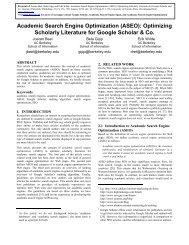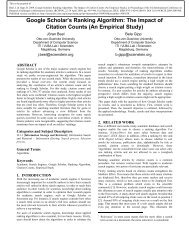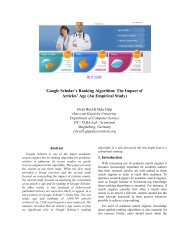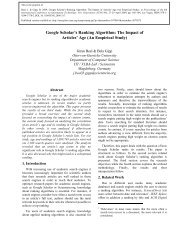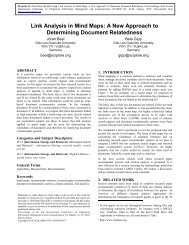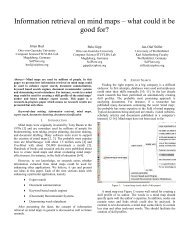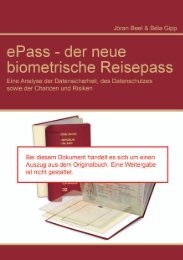Identifying related documents for research paper ... - Beel.org
Identifying related documents for research paper ... - Beel.org
Identifying related documents for research paper ... - Beel.org
You also want an ePaper? Increase the reach of your titles
YUMPU automatically turns print PDFs into web optimized ePapers that Google loves.
Preprint of: Bela Gipp and Jöran <strong>Beel</strong>. <strong>Identifying</strong> Related Documents For Research Paper Recommender By CPA And COA. In S. I. Ao, C. Douglas, W. S.<br />
Grundfest, and J. Burgstone, editors, International Conference on Education and In<strong>for</strong>mation Technology (ICEIT'09), volume 1 of Lecture Notes in Engineering<br />
and Computer Science, pages 636–639, Berkeley (USA), October 2009. International Association of Engineers (IAENG), Newswood Limited. ISBN 978-988-<br />
17012-6-8. Downloaded from http://www.sciplore.<strong>org</strong><br />
<strong>Identifying</strong> Related Documents For Research Paper<br />
Recommender By CPA and COA<br />
Abstract—This work-in-progress <strong>paper</strong> introduces two new<br />
approaches called Citation Proximity Analysis (CPA) and<br />
Citation Order Analysis (COA). They can be applied to<br />
identify <strong>related</strong> <strong>documents</strong> <strong>for</strong> the purpose of <strong>research</strong> <strong>paper</strong><br />
recommender systems. CPA is a variant of co-citation<br />
analysis that additionally considers the proximity of citations<br />
to each other within an article’s full-text. The underlying<br />
idea is that the closer citations are to each other in a<br />
document, the more likely it is that the cited <strong>documents</strong> are<br />
<strong>related</strong>. For example, citations listed in the same sentence<br />
are more likely to express <strong>related</strong> thoughts than citations<br />
listed only in the same section. In COA, the order of citations<br />
are considered, allowing the identification of a text similar to<br />
one that has been translated from language A to language B,<br />
as the citations would still occur in the same order. However,<br />
it is also shown that CPA and COA cannot replace text<br />
analysis and existing citation analysis approaches <strong>for</strong><br />
<strong>research</strong> <strong>paper</strong> recommender systems since they all have<br />
their own strengths and weaknesses.<br />
Index Terms—Bibliometrics, citation proximity analysis,<br />
citation order analysis, <strong>related</strong> <strong>documents</strong>, <strong>research</strong> <strong>paper</strong><br />
recommender<br />
I. INTRODUCTION<br />
The search <strong>for</strong> <strong>related</strong> work is a time-consuming procedure<br />
that even if per<strong>for</strong>med by experienced scientists often leads<br />
to unsatisfying results. To alleviate the problem, search<br />
engines such as Google Scholar and Citeseer offer to<br />
display “similar” <strong>documents</strong> based on text and citation<br />
analysis.<br />
Superior results are usually achieved by hybrid <strong>research</strong><br />
<strong>paper</strong> recommender systems. By combining further<br />
techniques such as co-word analysis, collaborative<br />
Bela Gipp and Jöran <strong>Beel</strong> are with the Otto-von-Guericke<br />
University Magdeburg, Department of Computer Science, ITI<br />
and SciPlore.<strong>org</strong> (gipp|beel@sciplore.<strong>org</strong>).<br />
Bela Gipp and Jöran <strong>Beel</strong><br />
filtering, Subject-Action-Object (SAO) structures, etc.,<br />
more precise recommendations can be given. However,<br />
these approaches are only suitable to a limited extent <strong>for</strong><br />
identifying <strong>related</strong> work [2-8].<br />
Taking everything into account, our examination suggests<br />
that in the case of scientific <strong>documents</strong>, usually the best<br />
results can be achieved by applying co-citation analysis.<br />
Citation proximity analysis is a further development of cocitation<br />
analysis.<br />
Cockpit View<br />
Graphical View (relevant <strong>documents</strong> are larger)<br />
Collaborative<br />
Document<br />
Evaluation<br />
Legend<br />
Data Mining<br />
Evaluating Collaborative Recommender Systems<br />
JL Herlocker, JA Konstan, G Terveen and JT Riedl<br />
2006, Journal of Science and Recommenders (IF 3.2)<br />
Abstract: Recommender systems have been evaluated Content in many, Based<br />
often incomparable, ways. In this <strong>paper</strong> we review the Recommender<br />
key<br />
decisions in evaluating collaborative filtering recommender Systems<br />
systems… More<br />
Tags: Recommender Systems Collaboration Evaluation Metrics<br />
Per<strong>for</strong>mance Measurement<br />
Unrat 0-2 2-4 4-6 6-8 8-10 Collaborative R.<br />
Server connection with Scienstein.<strong>org</strong> established Data processing completed<br />
Recommender<br />
Systems<br />
Impact<br />
Filter<br />
Publication date between:<br />
2002 and 2008<br />
Select languages<br />
Publication types<br />
Relevance:<br />
Impact factor:<br />
2002 2003 2004 2005 2006 2007 2008 Year<br />
Year<br />
Settings<br />
23<br />
7.5<br />
2.5<br />
Collaborative rating:<br />
3.2<br />
Topicality<br />
2.5<br />
Change Query<br />
Figure 1: GUI SciPlore – clustering similar <strong>documents</strong><br />
In the <strong>research</strong> <strong>paper</strong> recommender SciPlore.<strong>org</strong> this<br />
approach is mainly used <strong>for</strong> two purposes. First, to cluster<br />
similar <strong>documents</strong> as shown in Figure 1; and secondly, to<br />
give recommendations <strong>for</strong> further <strong>related</strong> <strong>documents</strong> based<br />
on one or more <strong>documents</strong> the user has been interested in,<br />
as shown in Figure 2.<br />
In the first part of this <strong>paper</strong> <strong>related</strong> work is presented and<br />
the commonly applied citation analysis approaches<br />
discussed with the focus on co-citation analysis. In the<br />
following section the CPA approach is introduced.<br />
Afterwards, the existing citation analysis approaches are<br />
compared to CPA and their suitability <strong>for</strong> <strong>research</strong> <strong>paper</strong><br />
systems examined. The <strong>paper</strong> concludes with a summary<br />
and an outlook which includes how this new approach is
going to be integrated in the <strong>research</strong> <strong>paper</strong> recommender<br />
SciPlore.<strong>org</strong>.<br />
Based on document usage mining, Scienstein recommends<br />
you the following <strong>paper</strong>s:<br />
Papers similar to the last <strong>paper</strong>s you have read<br />
The delicate topic of the impact factor<br />
Why the impact factor of journals should not be used <strong>for</strong><br />
evaluating <strong>research</strong><br />
Impact Factor: Good Reasons <strong>for</strong> Concern<br />
more... M. Szklo (2008),<br />
Epidemiology, vol. 19, no. 3<br />
Papers recently published by authors you have read<br />
Figure 2: Similar <strong>paper</strong> recommendation<br />
Self-citations, co-authorships and keywords - A new approach<br />
to scientists’ field mobility<br />
Profiling citation impact - A new methodology<br />
more... II. RELATED WORK<br />
The usefulness of a <strong>research</strong> <strong>paper</strong> recommender system<br />
depends Title to a large Author extent on its Year ability to automatically Update<br />
Source Ratings Abstract<br />
determine <strong>related</strong> work to one or more <strong>documents</strong>. Various<br />
approaches exist to determine the degree of similarity of<br />
<strong>documents</strong> in order to identify <strong>related</strong> work.<br />
Whereas text-mining approaches are used in cases in<br />
which references are not stated, citation analysis<br />
approaches usually deliver superior results as e.g.<br />
synonyms and unclear nomenclature do not lead to<br />
misleading results [3, 4, 5]. Many citation analysis<br />
approaches exist and they all have their own strengths and<br />
weaknesses <strong>for</strong> identifying similar <strong>documents</strong>. Among the<br />
most widely used are the easily applicable „cited by‟<br />
approach, which considers <strong>paper</strong>s as relevant that cite the<br />
same input document and the „reference list‟ approach,<br />
which considers <strong>paper</strong>s as relevant that were referenced by<br />
the input document. The best results can usually be<br />
obtained by bibliographic coupling and co-citation<br />
analysis, which allow calculating the coupling strength<br />
[6]. These approaches, which were already invented in the<br />
60s and 70s, are used by scientists and on academic search<br />
engine websites like CiteSeer1 [9].<br />
1 http://citeseer.ist.psu.edu<br />
Doc A<br />
citing<br />
cites<br />
Doc<br />
C<br />
Doc<br />
D<br />
Doc<br />
E<br />
Doc B<br />
citing<br />
cites<br />
Figure 3: Bibliographic coupling<br />
Documents are bibliographically coupled if they cite one or<br />
more <strong>documents</strong> in common. Figure 3 illustrates this<br />
approach: Papers A and B are <strong>related</strong> because they both<br />
cite <strong>paper</strong>s C, D and E.<br />
In contrast, two <strong>documents</strong> are “co-cited” when at least<br />
one <strong>paper</strong> cites both. This approach is illustrated in Figure<br />
4: Papers A and B are <strong>related</strong> because they are both cited<br />
by <strong>paper</strong>s C, D and E. The more co-citations two <strong>paper</strong>s<br />
receive, the more <strong>related</strong> they are [6].<br />
Doc A<br />
cited<br />
Doc<br />
C<br />
cites<br />
Doc<br />
D<br />
cites<br />
Doc<br />
E<br />
Doc B<br />
cited<br />
Figure 4: Co-citation analysis<br />
Although both approaches are suitable to identify similar<br />
<strong>paper</strong>s, they serve different purposes. Whereas<br />
bibliographic coupling is retrospective, co-citation is<br />
essentially a <strong>for</strong>ward-looking perspective [9]. However,<br />
both approaches often deliver unsatisfying results, since<br />
they only make use of the bibliography at the end of the<br />
document without analyzing the constellation of citations.<br />
There<strong>for</strong>e it is not possible to determine in which part of a<br />
<strong>related</strong> document the content of interest can be found.<br />
III. CITATION PROXIMITY ANALYSIS AND<br />
CITATION ORDER ANALYSIS<br />
Instead of just using the bibliography, in CPA the<br />
in<strong>for</strong>mation derived from the proximity of the citations to<br />
each other in the full-text is used to calculate the Citation<br />
Proximity Index (CPI) in three steps.
1. The document is parsed and a series of heuristics are<br />
used to process the citations including their position within<br />
the document2.<br />
2. The citations are assigned to their corresponding items<br />
in the bibliography. The overall margin of error with the<br />
system we have developed equals nearly three percent <strong>for</strong><br />
the first and second step.<br />
3. In the third step the proximity among each citation-pair<br />
is examined. The underlying assumption is that the closer<br />
the citations are to each other, the more likely it is that<br />
they are <strong>related</strong>. Based on this proximity analysis, the CPI<br />
is calculated. If <strong>for</strong> example two citations are given in the<br />
same sentence the probability that they are very similar is<br />
higher (CPI = 1) as if they were only in the same<br />
paragraph (CPI = ¼). See Figure 5.<br />
Document 1 Document 2 Document 3<br />
This is an example text with references to different <strong>documents</strong>.[1]<br />
Another example. This is an example text with references to<br />
different <strong>documents</strong>.This is an example text with references to<br />
different <strong>documents</strong>. This is one reference [1], [2]. This is an<br />
example text with references to different <strong>documents</strong>. Another<br />
example. This is an example text with references to different<br />
<strong>documents</strong>.This is an example text with references to different<br />
<strong>documents</strong>.Another example. Another example.<br />
Another example. This is an example text with references to<br />
different <strong>documents</strong>.This is an example text with references to<br />
different <strong>documents</strong>. Another example [3]. This is an example text<br />
with references to different <strong>documents</strong>.Another example. Another<br />
example. This is an example text with references to different<br />
<strong>documents</strong> [1]. Another exampleThis is an example text with<br />
references to different <strong>documents</strong>.<br />
This is an example text with references to different <strong>documents</strong>.<br />
Another example. This is an example text with references to<br />
different <strong>documents</strong>. Another example. This is an example text<br />
with references to different <strong>documents</strong>.Another example. Another<br />
example. Another example. This is an example text with<br />
references to different <strong>documents</strong>.Another example.<br />
Another example. This is an example text with references to<br />
different <strong>documents</strong>.Another example. This is another reference<br />
[2]. Another example. This is an example text with references to<br />
different <strong>documents</strong>.Another example. This is an example text<br />
with references to different <strong>documents</strong>. Example. This is an<br />
example text with references to different <strong>documents</strong>.<br />
Citing Document<br />
This is an example text with references to different <strong>documents</strong>.<br />
This is one reference. This is an example text with references to<br />
different <strong>documents</strong>. Two very similar references [1],[2]. This is an<br />
example text with references to different <strong>documents</strong>.This is an<br />
example text with references to different <strong>documents</strong>.Another<br />
example. Another example.<br />
This is an example text with references to different <strong>documents</strong>.<br />
Another example. This is an example text with references to<br />
different <strong>documents</strong>.<br />
This is an example text with references to different <strong>documents</strong>.<br />
Another example. This is an example text with references to<br />
different <strong>documents</strong>. Another example. This is an example text<br />
with references to different <strong>documents</strong>.Another example. Another<br />
example. Another example. This is an example text with<br />
references to different <strong>documents</strong>.Another example.<br />
Another example. This is an example text with references to<br />
different <strong>documents</strong>.This is an example text with references to<br />
different <strong>documents</strong>. Another example. This is an example text<br />
with references to different <strong>documents</strong>.Another example. Another<br />
example. This is an example text with references to different<br />
<strong>documents</strong> [3]. Another exampleThis is an example text with<br />
references to different <strong>documents</strong>.<br />
Another example. This is an example text with references to<br />
different <strong>documents</strong>.Another example. This is another reference.<br />
Another example. This is an example text with references to<br />
different <strong>documents</strong>.Another example. This is an example text<br />
with references to different <strong>documents</strong>. Example. This is an<br />
example text with references to different <strong>documents</strong>.<br />
This is an example text with references to different <strong>documents</strong>.<br />
Another example. This is an example text with references to<br />
different <strong>documents</strong>. Another example. This is an example text<br />
with references to different <strong>documents</strong>.Another example. Another<br />
example. Another example. This is an example text with<br />
references to different <strong>documents</strong>.Another example.<br />
Another example. This is an example text with references to<br />
different <strong>documents</strong>.This is an example text with references to<br />
different <strong>documents</strong>. Another example [3]. This is an example text<br />
with references to different <strong>documents</strong>.Another example. Another<br />
example. This is an example text with references to different<br />
<strong>documents</strong> [1]. Another exampleThis is an example text with<br />
references to different <strong>documents</strong>.<br />
Another example. This is an example text with references to<br />
different <strong>documents</strong>.Another example. This is another reference<br />
[2]. Another example. This is an example text with references to<br />
different <strong>documents</strong>.Another example. This is an example text<br />
with references to different <strong>documents</strong>. Example. This is an<br />
example text with references to different <strong>documents</strong>.<br />
This is an example text with references to different <strong>documents</strong>.<br />
This is one reference [1], [2]. This is an example text with<br />
references to different <strong>documents</strong>. Another example. This is an<br />
example text with references to different <strong>documents</strong>.This is an<br />
example text with references to different <strong>documents</strong>.Another<br />
example. Another example.<br />
CPI = ¼ CPI = 1<br />
Figure 5: Illustration CPA<br />
Another example. This is an example text with references to<br />
different <strong>documents</strong>.This is an example text with references to<br />
different <strong>documents</strong>. Another example [3]. This is an example text<br />
with references to different <strong>documents</strong>.Another example. Another<br />
example. This is an example text with references to different<br />
<strong>documents</strong> [1]. Another exampleThis is an example text with<br />
references to different <strong>documents</strong>.<br />
Another example. This is an example text with references to<br />
different <strong>documents</strong>.Another example. This is another reference<br />
[2]. Another example. This is an example text with references to<br />
different <strong>documents</strong>.Another example. This is an example text<br />
with references to different <strong>documents</strong>. Example. This is an<br />
example text with references to different <strong>documents</strong>.<br />
This is an example text with references to different <strong>documents</strong>.<br />
This is one reference [1], [2]. This is an example text with<br />
references to different <strong>documents</strong>. Another example. This is an<br />
example text with references to different <strong>documents</strong>.This is an<br />
example text with references to different <strong>documents</strong>.Another<br />
example. Another example.<br />
This is an example text with references to different <strong>documents</strong>.[1]<br />
Another example. This is an example text with references to<br />
different <strong>documents</strong>.<br />
This is an example text with references to different <strong>documents</strong>.<br />
Another example. This is an example text with references to<br />
different <strong>documents</strong>. Another example. This is an example text<br />
with references to different <strong>documents</strong>.Another example. Another<br />
example.<br />
However, further <strong>research</strong> needs to be per<strong>for</strong>med to<br />
identify the appropriate weighting of the CPI values<br />
according to their occurrence, which also seems to depend<br />
on the publication‟s <strong>research</strong> field and publication‟s<br />
<strong>research</strong> type. For example, it seems that <strong>for</strong> analyzing a<br />
technical report or patent specification, different<br />
weightings seem suitable. First empirical evaluations have<br />
2 The citations were parsed using a modified version of parsCit<br />
(http://wing.comp.nus.edu.sg/parsCit) in combination with<br />
exclusively developed software, which is available upon<br />
request from the authors.<br />
lead to the values shown in Table 1 <strong>for</strong> calculating the<br />
CPI.<br />
Table 1: CPI values<br />
Occurrence CPI value<br />
Sentence 1<br />
Paragraph 1/2<br />
Chapter 1/4<br />
Same journal / same book 1/8<br />
Same journal but different edition 1/16<br />
The results delivered by CPA can be improved by<br />
evaluating as many sources as possible. This can be the<br />
case due to multiple occurrences of the same citation and<br />
due to multiple <strong>documents</strong> citing a certain document. In<br />
our series of tests we experienced the best results by<br />
calculating the weighted average of the CPIs. By<br />
automating the process described above, we have<br />
calculated the CPI <strong>for</strong> publications contained in the<br />
SciPlore database. The results show that in comparison to<br />
the results delivered by co-citation analysis, CPA delivers<br />
considerably better results in identifying similar<br />
<strong>documents</strong> [1].<br />
Similar to the idea of CPA is another approach currently<br />
under development, that we call Citation Order Analysis<br />
(COA). In contrast to CPA, in COA, only the order of<br />
citations is considered. The main advantage in comparison<br />
to the usually applied text analysis approaches is that even<br />
if <strong>documents</strong> are translated or paraphrased they can still be<br />
identified as similar. Depending on the level of tolerance<br />
even if citations were omitted, summarized <strong>documents</strong> can<br />
be identified. This way a digital fingerprint of <strong>documents</strong><br />
can be created that can, besides <strong>for</strong> recommender systems,<br />
also be used to identify plagiarized work. In some regard,<br />
this approach is similar to bibliographic coupling.<br />
However, by additionally considering the order of<br />
citations, this approach is more precise and robust. Figure<br />
6 illustrates the concept.
Document A<br />
This is an example text with references to different <strong>documents</strong>.<br />
This is one reference. This is an example text with references to<br />
different <strong>documents</strong>. Two very similar references [1],[2]. This is an<br />
example text with references to different <strong>documents</strong>.This is an<br />
example text with references to different <strong>documents</strong>.Another<br />
example. Another example.<br />
This is an example text with references to different <strong>documents</strong>.<br />
Another example. This is an example text with references to<br />
different <strong>documents</strong>.<br />
This is an example text with references to different <strong>documents</strong>.<br />
Another example. This is an example text with references to<br />
different <strong>documents</strong>. Another example. This is an example text<br />
with references to different <strong>documents</strong>.Another example. Another<br />
example. Another example. This is an example text with<br />
references to different <strong>documents</strong>.Another example.<br />
Another example. This is an example text with references to<br />
different <strong>documents</strong>.This is an example text with references to<br />
different <strong>documents</strong>. Another example. This is an example text<br />
with references to different <strong>documents</strong>.Another example. Another<br />
example. This is an example text with references to different<br />
<strong>documents</strong> [3]. Another exampleThis is an example text with<br />
references to different <strong>documents</strong>.<br />
Another example. This is an example text with references to<br />
different <strong>documents</strong>.Another example. This is another reference.<br />
Another example. This is an example text with references to<br />
different <strong>documents</strong>.Another example. This is an example text<br />
with references to different <strong>documents</strong>. Example. This is an<br />
example text with references to different <strong>documents</strong>.<br />
This is an example<br />
text with<br />
references to<br />
different<br />
<strong>documents</strong>.[1]<br />
Another example.<br />
This is an example<br />
This is an example<br />
text with<br />
references to<br />
different<br />
<strong>documents</strong>.[1]<br />
Another example.<br />
This is an example<br />
text with<br />
references to<br />
different<br />
<strong>documents</strong>.This is<br />
an ex<br />
This is an example<br />
text with<br />
references to<br />
different<br />
<strong>documents</strong>.This is<br />
an ex<br />
asdasdasd<br />
Document B<br />
This is an example text with references to different <strong>documents</strong>.[1]<br />
Another example. This is an example text with references to<br />
different <strong>documents</strong>.This is an example text with references to<br />
different <strong>documents</strong>. This is one reference [1], [2]. This is an<br />
example text with references to different <strong>documents</strong>. Another<br />
example. This is an example text with references to different<br />
<strong>documents</strong>.This is an example text with references to different<br />
<strong>documents</strong>.Another example. Another example.<br />
Another example. This is an example text with references to<br />
different <strong>documents</strong>.This is an example text with references to<br />
different <strong>documents</strong>. Another example [3]. This is an example text<br />
with references to different <strong>documents</strong>.Another example. Another<br />
example. This is an example text with references to different<br />
<strong>documents</strong> [1]. Another exampleThis is an example text with<br />
references to different <strong>documents</strong>.<br />
This is an example text with references to different <strong>documents</strong>.<br />
Another example. This is an example text with references to<br />
different <strong>documents</strong>. Another example. This is an example text<br />
with references to different <strong>documents</strong>.Another example. Another<br />
example. Another example. This is an example text with<br />
references to different <strong>documents</strong>.Another example.<br />
Another example. This is an example text with references to<br />
different <strong>documents</strong>.Another example. This is another reference<br />
[2]. Another example. This is an example text with references to<br />
different <strong>documents</strong>.Another example. This is an example text<br />
with references to different <strong>documents</strong>. Example. This is an<br />
example text with references to different <strong>documents</strong>.<br />
Figure 6: Illustration Citation Order Analysis<br />
IV. OUTLOOK<br />
Besides identifying <strong>related</strong> work, the authors work on<br />
applying the idea behind CPA <strong>for</strong> automatic document<br />
classification <strong>for</strong> the <strong>research</strong> <strong>paper</strong> recommender SciPlore<br />
[11]. The aim is to automatically analyze the topics within<br />
<strong>documents</strong> by analyzing the distribution of references<br />
within <strong>research</strong> <strong>paper</strong>s. So instead of knowing, <strong>for</strong><br />
instance, that a certain publication focuses on the relativity<br />
theory, the CPA makes it possible to identify the document<br />
sections focusing <strong>for</strong> example, on „Time dilation’, „Length<br />
contraction‟ or „Mass-energy equivalence‟ and then to<br />
give specific recommendations within <strong>documents</strong> or books.<br />
Moreover, it is possible to combine the CPA with text<br />
mining algorithms in order to automatically detect e.g.<br />
contradicting studies. “The author A has shown in his<br />
recent study [reference A] that in contrast to a previous<br />
study [reference B]...” So by analyzing the words between<br />
two references it is often possible to automatically analyze<br />
the exact relationship between these two references and<br />
how they compare to each other.<br />
Oftentimes it is possible by knowing the position of each<br />
citation within a document, to draw conclusions about the<br />
document type e.g. state-of-the art publications, etc. The<br />
gathered in<strong>for</strong>mation can be used to classify further<br />
<strong>documents</strong> and to develop a more sophisticated „Web of<br />
Science‟. We believe that these technologies, in<br />
combination with collaborative filtering, will be the future<br />
<strong>for</strong> identifying <strong>related</strong> work and will open the doors <strong>for</strong><br />
powerful <strong>research</strong> <strong>paper</strong> recommender systems.<br />
V. DISCUSSION & CONCLUSION<br />
As shown, the CPA and COA offer substantial advantages<br />
in identifying <strong>related</strong> <strong>documents</strong> in comparison to existing<br />
approaches. However, it should also be taken into account<br />
that the ef<strong>for</strong>t is considerable. It is not sufficient to<br />
evaluate the bibliography of <strong>documents</strong>, but it is necessary<br />
to process the complete document, identify each reference<br />
and map it to the corresponding entry in the bibliography,<br />
which is in practice not always possible, and leads in ca.<br />
3% of cases to mismatches. This is because sometimes<br />
only an abstract and the bibliography can be accessed,<br />
<strong>documents</strong> cannot be parsed as OCR fails, or a reference<br />
style is used that makes it unfeasible to automatically link<br />
references to the corresponding items in the bibliography.<br />
This leads to the conclusion that although these new<br />
approaches deliver superior results, they cannot completely<br />
replace the already existing approaches, but should be used<br />
in combination.<br />
REFERENCES<br />
[1] Gipp, B. & <strong>Beel</strong>, J. (2009). Citation Proximity<br />
Analysis (CPA) - A new approach <strong>for</strong> identifying<br />
<strong>related</strong> work based on Co-Citation Analysis. In<br />
Proceedings of the 12th International Conference on<br />
Scientometrics and In<strong>for</strong>metrics, pp. 571-575.<br />
[2] Rip, A., & Courtial, J. (1984). Co-Word Maps of<br />
Biotechnology: An Example of Cognitive<br />
Scientometrics. Scientometrics, 6(6), 381-400.<br />
[3] Fano, R. M. 1956. In<strong>for</strong>mation theory and the<br />
retrieval of recorded in<strong>for</strong>mation, in Documentation in<br />
Action, Shera, J. H. Kent, A. Perry, J. W. (Edts), New<br />
York: Reinhold Publ. Co., pp. 238–244.<br />
[4] Marshakova, I. V. 1973. System of document<br />
connections based on references, Nauchno-<br />
Tekhnicheskaya In<strong>for</strong>matsiya, vol. 2, no. 6, pp. 3–8.<br />
[5] <strong>Beel</strong>, J. & Gipp, B. 2008, The Potential of<br />
Collaborative Document Evaluation <strong>for</strong> Science, the<br />
11th International Conference on Digital Asian<br />
Libraries (ICADL 2008), December 2 - 5, Kuta,<br />
Indonesia, published in G. Buchanan, M. Masoodian<br />
& S. Cunningham (Eds.), Digital Libraries: Universal<br />
and Ubiquitous Access to In<strong>for</strong>mation of Lecture<br />
Notes in Computer Science, vol. 5362, DOI<br />
10.1007/978-3-540-89533-6, ISSN 0302-9743, pp.<br />
375-378, Springer-Verlag Berlin Heidelberg.<br />
[6] Small, H. 1973. Co-citation in the scientific<br />
literature: a new measure of the relationship between<br />
two <strong>documents</strong>, Journal of the American Society <strong>for</strong><br />
In<strong>for</strong>mation Science, vol. 24, pp. 265–269.<br />
[7] Klavans, R., & Boyack, K. (2006). <strong>Identifying</strong> a better<br />
measure of <strong>related</strong>ness <strong>for</strong> mapping science, Journal of<br />
the American Society <strong>for</strong> In<strong>for</strong>mation Science and<br />
Technology, Vol. 57, No. 2, pp. 251-263.<br />
[8] Sternitzke, C. Bergmann, I. (2009), Similarity<br />
measures <strong>for</strong> document mapping: A comparative study
on the level of an individual scientist, Scientometrics,<br />
Vol. 78, No. 1, pp. 113-130.<br />
[9] Garfield, E. (2001, November 27, 2001). From<br />
Bibliographic Coupling to Co-CitationAnalysis Via<br />
Algorithmic Historio-Bibliography: A Citationist‟s<br />
Tribute to BelverC. Griffith. Paper presented at the<br />
Drexel University, Philadelphia, PA.<br />
[10] Giles, C. L. Bollacker, K. D. And Lawrence, S. 1998.<br />
CiteSeer: an automatic citation indexing system, In<br />
Digital Libraries 98 - The Third ACM Conference on<br />
Digital Libraries, pp. 89-98.<br />
[11] Gipp, B. <strong>Beel</strong>, J. & Hentschel, C. (2009), Scienstein -<br />
A Research Paper Recommender System, in<br />
Proceedings of IEEE International Conference on<br />
Emerging Trends in Computing. Tamil Nadu, India.



